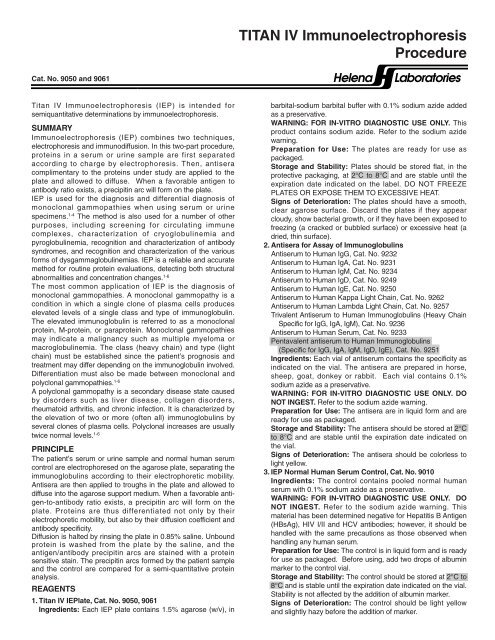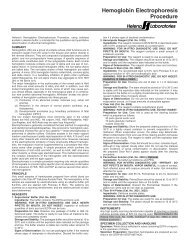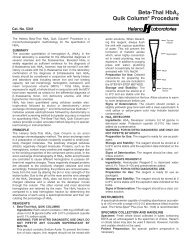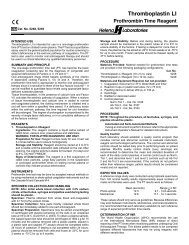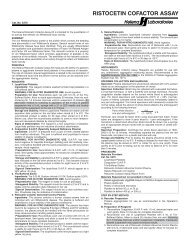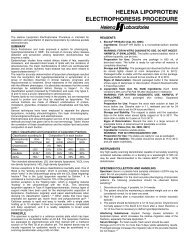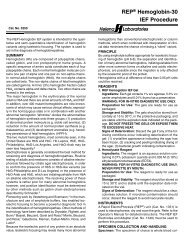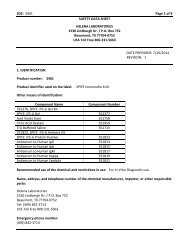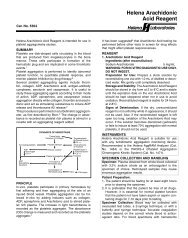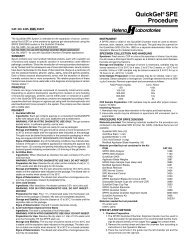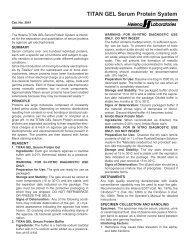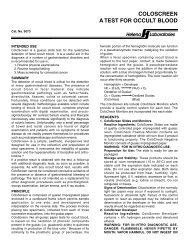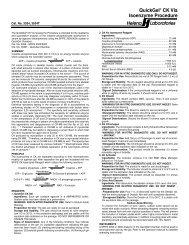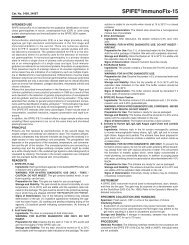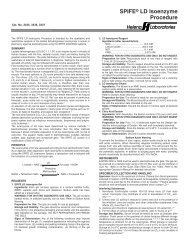TITAN IV Immunoelectrophoresis Procedure - Helena Laboratories
TITAN IV Immunoelectrophoresis Procedure - Helena Laboratories
TITAN IV Immunoelectrophoresis Procedure - Helena Laboratories
You also want an ePaper? Increase the reach of your titles
YUMPU automatically turns print PDFs into web optimized ePapers that Google loves.
<strong>TITAN</strong> <strong>IV</strong> <strong>Immunoelectrophoresis</strong><br />
<strong>Procedure</strong><br />
Cat. No. 9050 and 9061<br />
<strong>Helena</strong><br />
<strong>Laboratories</strong><br />
Titan <strong>IV</strong> <strong>Immunoelectrophoresis</strong> (IEP) is intended for<br />
semiquantitative determinations by immunoelectrophoresis.<br />
SUMMARY<br />
<strong>Immunoelectrophoresis</strong> (IEP) combines two techniques,<br />
electrophoresis and immunodiffusion. In this two-part procedure,<br />
proteins in a serum or urine sample are first separated<br />
according to charge by electrophoresis. Then, antisera<br />
complimentary to the proteins under study are applied to the<br />
plate and allowed to diffuse. When a favorable antigen to<br />
antibody ratio exists, a precipitin arc will form on the plate.<br />
IEP is used for the diagnosis and differential diagnosis of<br />
monoclonal gammopathies when using serum or urine<br />
specimens. 1-4 The method is also used for a number of other<br />
purposes, including screening for circulating immune<br />
complexes, characterization of cryoglobulinemia and<br />
pyroglobulinemia, recognition and characterization of antibody<br />
syndromes, and recognition and characterization of the various<br />
forms of dysgammaglobulinemias. IEP is a reliable and accurate<br />
method for routine protein evaluations, detecting both structural<br />
abnormalities and concentration changes. 1-6<br />
The most common application of IEP is the diagnosis of<br />
monoclonal gammopathies. A monoclonal gammopathy is a<br />
condition in which a single clone of plasma cells produces<br />
elevated levels of a single class and type of immunoglobulin.<br />
The elevated immunoglobulin is referred to as a monoclonal<br />
protein, M-protein, or paraprotein. Monoclonal gammopathies<br />
may indicate a malignancy such as multiple myeloma or<br />
macroglobulinemia. The class (heavy chain) and type (light<br />
chain) must be established since the patient’s prognosis and<br />
treatment may differ depending on the immunoglobulin involved.<br />
Differentiation must also be made between monoclonal and<br />
polyclonal gammopathies. 1-6<br />
A polyclonal gammopathy is a secondary disease state caused<br />
by disorders such as liver disease, collagen disorders,<br />
rheumatoid arthritis, and chronic infection. It is characterized by<br />
the elevation of two or more (often all) immunoglobulins by<br />
several clones of plasma cells. Polyclonal increases are usually<br />
twice normal levels. 1-6<br />
PRINCIPLE<br />
The patient’s serum or urine sample and normal human serum<br />
control are electrophoresed on the agarose plate, separating the<br />
immunoglobulins according to their electrophoretic mobility.<br />
Antisera are then applied to troughs in the plate and allowed to<br />
diffuse into the agarose support medium. When a favorable antigen-to-antibody<br />
ratio exists, a precipitin arc will form on the<br />
plate. Proteins are thus differentiated not only by their<br />
electrophoretic mobility, but also by their diffusion coefficient and<br />
antibody specificity.<br />
Diffusion is halted by rinsing the plate in 0.85% saline. Unbound<br />
protein is washed from the plate by the saline, and the<br />
antigen/antibody precipitin arcs are stained with a protein<br />
sensitive stain. The precipitin arcs formed by the patient sample<br />
and the control are compared for a semi-quantitative protein<br />
analysis.<br />
REAGENTS<br />
1. Titan <strong>IV</strong> IEPlate, Cat. No. 9050, 9061<br />
Ingredients: Each IEP plate contains 1.5% agarose (w/v), in<br />
barbital-sodium barbital buffer with 0.1% sodium azide added<br />
as a preservative.<br />
WARNING: FOR IN-VITRO DIAGNOSTIC USE ONLY. This<br />
product contains sodium azide. Refer to the sodium azide<br />
warning.<br />
Preparation for Use: The plates are ready for use as<br />
packaged.<br />
Storage and Stability: Plates should be stored flat, in the<br />
protective packaging, at 2°C to 8°C and are stable until the<br />
expiration date indicated on the label. DO NOT FREEZE<br />
PLATES OR EXPOSE THEM TO EXCESS<strong>IV</strong>E HEAT.<br />
Signs of Deterioration: The plates should have a smooth,<br />
clear agarose surface. Discard the plates if they appear<br />
cloudy, show bacterial growth, or if they have been exposed to<br />
freezing (a cracked or bubbled surface) or excessive heat (a<br />
dried, thin surface).<br />
2. Antisera for Assay of Immunoglobulins<br />
Antiserum to Human IgG, Cat. No. 9232<br />
Antiserum to Human IgA, Cat. No. 9231<br />
Antiserum to Human IgM, Cat. No. 9234<br />
Antiserum to Human IgD, Cat. No. 9249<br />
Antiserum to Human IgE, Cat. No. 9250<br />
Antiserum to Human Kappa Light Chain, Cat. No. 9262<br />
Antiserum to Human Lambda Light Chain, Cat. No. 9257<br />
Trivalent Antiserum to Human Immunoglobulins (Heavy Chain<br />
Specific for IgG, IgA, IgM), Cat. No. 9236<br />
Antiserum to Human Serum, Cat. No. 9233<br />
Pentavalent antiserum to Human Immunoglobulins<br />
(Specific for IgG, IgA, IgM, IgD, IgE), Cat. No. 9251<br />
Ingredients: Each vial of antiserum contains the specificity as<br />
indicated on the vial. The antisera are prepared in horse,<br />
sheep, goat, donkey or rabbit. Each vial contains 0.1%<br />
sodium azide as a preservative.<br />
WARNING: FOR IN-VITRO DIAGNOSTIC USE ONLY. DO<br />
NOT INGEST. Refer to the sodium azide warning.<br />
Preparation for Use: The antisera are in liquid form and are<br />
ready for use as packaged.<br />
Storage and Stability: The antisera should be stored at 2°C<br />
to 8°C and are stable until the expiration date indicated on<br />
the vial.<br />
Signs of Deterioration: The antisera should be colorless to<br />
light yellow.<br />
3. IEP Normal Human Serum Control, Cat. No. 9010<br />
Ingredients: The control contains pooled normal human<br />
serum with 0.1% sodium azide as a preservative.<br />
WARNING: FOR IN-VITRO DIAGNOSTIC USE ONLY. DO<br />
NOT INGEST. Refer to the sodium azide warning. This<br />
material has been determined negative for Hepatitis B Antigen<br />
(HBsAg), H<strong>IV</strong> I/II and HCV antibodies; however, it should be<br />
handled with the same precautions as those observed when<br />
handling any human serum.<br />
Preparation for Use: The control is in liquid form and is ready<br />
for use as packaged. Before using, add two drops of albumin<br />
marker to the control vial.<br />
Storage and Stability: The control should be stored at 2°C to<br />
8°C and is stable until the expiration date indicated on the vial.<br />
Stability is not affected by the addition of albumin marker.<br />
Signs of Deterioration: The control should be light yellow<br />
and slightly hazy before the addition of marker.
4. Electra ® B 1 Buffer, Cat. No. 5016<br />
Ingredients: Contains barbital-sodium barbital, pH 8.3-8.7.<br />
WARNING: FOR IN-VITRO DIAGNOSTIC USE ONLY. DO<br />
NOT INGEST. The buffer contains barbital which, in sufficient<br />
quantity, can be toxic.<br />
Preparation for Use: Dissolve one package of buffer in one<br />
liter of deionized water. The buffer is ready for use when it is<br />
completely dissolved.<br />
Storage and Stability: The packaged, dry buffer should be<br />
stored at room temperature (15 to 30°C) and is stable until the<br />
expiration date on the package. Buffer solution is stable for<br />
two months at 15 to 30°C.<br />
Signs of Deterioration: Discard packaged buffer if the<br />
material shows signs of dampness or discoloration. Discard<br />
buffer solution if it becomes turbid.<br />
5. Albumin Marker, Cat. No. 9011<br />
Ingredients: The albumin marker is 0.5% bromophenol blue<br />
in aqueous solution.<br />
WARNING: FOR IN-VITRO DIAGNOSTIC USE ONLY. DO<br />
NOT INGEST.<br />
Preparation for Use: Add two drops of Albumin Marker to<br />
each vial of IEP Normal Human Serum Control. The<br />
bromophenol blue binds with the albumin in the control. The<br />
tagged albumin allows verification of protein mobility during<br />
electrophoresis.<br />
Storage and Stability: The marker should be stored at 15<br />
to 30°C and is stable until the expiration date indicated on<br />
the vial.<br />
Signs of Deterioration: Discard if the solution color changes<br />
from the yellow-brown color.<br />
SODIUM AZIDE WARNING<br />
To prevent the formation of toxic vapors, do not mix with acidic<br />
solutions. When discarding, always flush sink with copious<br />
amounts of water. This will prevent the formation of metallic<br />
azides which, when highly concentrated in metal plumbing, are<br />
potentially explosive. In addition to purging pipes with water,<br />
plumbing should occasionally be decontaminated with 10%<br />
NaOH.<br />
SPECIMEN COLLECTION AND HANDLING<br />
Specimen: Fresh human serum or urine are the specimens of<br />
choice. Urine samples should be tested unconcentrated as well<br />
as concentrated (10X to 50X) due to the wide range of light<br />
chain concentrations.<br />
Patient Preparation: No special patient preparation is<br />
necessary.<br />
Interfering Factors:<br />
1. Samples showing evidence of hemolysis should not be used.<br />
2. Inaccurate results may be obtained on specimens left<br />
uncovered, due to evaporation.<br />
3. Microbial contamination of samples will cause protein<br />
denaturation affecting results.<br />
4. Patient age, sex, history and clinical presentation will affect<br />
immunoglobulin levels and must be considered.<br />
Storage and Stability: Serum and urine samples should be<br />
assayed fresh if possible. Samples may be stored at 2 to 8°C for<br />
up to 5 days after collection. Serum and urine refrigerated<br />
samples should be warmed to room temperature and mixed well<br />
prior to testing.<br />
PROCEDURE<br />
Materials Provided by <strong>Helena</strong>:<br />
Cat. No.<br />
Titan <strong>IV</strong> IEPlates, 8 wells, 7 troughs 9050<br />
Titan <strong>IV</strong> IEPlates, 7 wells, 6 troughs 9061<br />
Electra ® B 1 Buffer 5016<br />
IEP Normal Human Serum Control<br />
Albumin Marker<br />
9010<br />
9011<br />
Antiserum to Human IgG 9232<br />
Antiserum to Human IgA 9231<br />
Antiserum to Human IgM 9234<br />
Antiserum to Human IgD 9249<br />
Antiserum to Human IgE 9250<br />
Antiserum to Human Kappa Chain 9262<br />
Antiserum to Human Lambda Chain 9257<br />
Trivalent Antiserum to Human<br />
Immunoglobulins (IgG, IgA, IgM) 9236<br />
Pentavalent antiserum to Human Immunoglobulins<br />
(Specific for IgG, IgA, IgM, IgD, IgE), Cat. No. 9251<br />
Antiserum to Human Serum 9233<br />
Microdispenser and Tubes 6210<br />
<strong>TITAN</strong> GEL Chamber (Zip Zone ® Chamber,<br />
Cat. No. 1283, may be used) 4063<br />
IEP Sponge Wicks, Long 9015<br />
Materials Needed but Not Supplied:<br />
Saline Solution (0.85%)<br />
5% acetic acid<br />
SUMMARY OF CONDITIONS<br />
Plate . . . . . . . . . . . . . . . . . . . . . . . . . . . . . . . Titan <strong>IV</strong> IEPlate<br />
Buffer . . . . . . . . B 1 Buffer dissolved in 1.0 L deionized water<br />
Sample Volume. . . . . . . . . . . . . . . . . . . . . . . . . . . . . . . . 4 µL<br />
Migration Distance . . . . . . . . . . . . . . . Cat. No. 9061, 20 mm<br />
Cat. No. 9050, 35-40 mm<br />
Electrophoresis Time . . . . . . . . . . . . . . . . . . . 40-50 minutes<br />
Voltage . . . . . . . . . . . . . . . . . . . . . . . . . . . . . . . . . . . . . 100 V<br />
Antisera Volume . . . . . . . . . . . . . . Cat. No. 9050, 75-100 µL<br />
Cat. No. 9061, 150 µL<br />
Incubation Time . . . . . . . . . . . . . . . . . . . . . . . . . 18-24 hours<br />
Incubation Temperature . . . . . . . . . . . . . . . . . . . . 15 to 30°C<br />
Wash Solution . . . . . . . . . . . . . . . . . . . . . . . . . 0.85% Saline<br />
Saline Wash Time. . . . . . . . . . . . . . . . . . . . . . . . 48-72 hours<br />
Staining Time . . . . . . . . . . . . . . . . . . . . . . . . . . . . . . . 30 min.<br />
Destaining Time . . . . . . . . . . . . . . . . . . . . . . 90-180 minutes<br />
STEP-BY-STEP METHOD<br />
A.Preparation of <strong>TITAN</strong> GEL Chamber<br />
1. Dissolve 1 package of Electra B 1 Buffer in one liter of<br />
deionized water.<br />
2. Pour 100 mL of buffer into<br />
each outer section of the<br />
chamber (total of 200 mL of<br />
buffer used). The buffer can<br />
be reused one time by<br />
reversing the polarity of the<br />
chamber. The IEPlates must then be placed with the<br />
wells on the left side (formerly the anodic side).<br />
3. Place a long IEP Sponge Wick in each buffer-filled<br />
compartment. Allow the sponges to become saturated<br />
with buffer. Place the sponges against the chamber<br />
walls as shown.<br />
4. Cover the chamber until ready to use.<br />
B.Sample Application<br />
1. Remove the Titan <strong>IV</strong> IEPlate(s) from the refrigerator.<br />
Allow the plate(s) to come<br />
to room temperature prior<br />
to use (requires 20-30<br />
minutes).<br />
2. Add two drops of Albumin<br />
Marker to a vial of Normal<br />
Human Serum Control.<br />
3. Remove the lid from the<br />
plate.<br />
4. Apply 4 µL of the control to<br />
every other well in the plate
using a Microdispenser. Take care not to damage the<br />
wells during sample application.<br />
5. Apply 4 µL of the patient sample to every other well.<br />
C.Electrophoresis of the IEPlate(s)<br />
1. Quickly put the plate(s) in the electrophoresis chamber,<br />
agarose side down, with the wells toward the cathode (-<br />
) side of the chamber.<br />
Make sure that the agarose makes good contact with<br />
the sponge wicks. Two plates may be electrophoresed<br />
in one chamber.<br />
2. Put the cover on the electrophoresis chamber and wait<br />
30 to 60 seconds before applying current. This allows<br />
the plate(s) to equilibrate with the buffer.<br />
3. Electrophorese the plate(s) at 100 volts for the<br />
appropriate migration distance. This requires approximately<br />
40 to 50 minutes. Migration distance can be<br />
verified visually by observing the position of the Albumin<br />
Marker.<br />
The migration distances for the plates are as follows:<br />
Cat. No. 9061: 20 mm<br />
Cat. No. 9050: 35-40 mm<br />
D.Antisera Application<br />
1. Remove the plate(s) from the chamber and put them on<br />
a flat surface, agarose side up.<br />
2. Apply the appropriate antiserum to each trough in the<br />
plate using the appropriate volume of antisera as<br />
follows:<br />
Cat. No. 9061, 150 µL/trough<br />
Cat. No. 9050, 75-100 µL/trough<br />
Fill the troughs by placing the tip of a pipette in the end<br />
of the trough farthest from<br />
the sample well. Holding<br />
the pipette in place, slowly<br />
depress the plunger and<br />
dispense the antiserum<br />
into the trough. The<br />
antiserum will flow down<br />
the trough by capillary<br />
action. Severe overfilling<br />
may cause antisera to contaminate other troughs,<br />
yielding erroneous results.<br />
3. Before moving the plates, allow the antisera to absorb<br />
for approximately 3 to 5<br />
minutes.<br />
4. Stack the plates in an<br />
enclosed container with a<br />
moist paper wick.<br />
5. Incubate the plate(s) for<br />
18 to 24 hours at room<br />
temperature (15 to 30°C).<br />
The minimum incubation<br />
time is 18 hours. After<br />
incubation, place the<br />
plates in a 0.85% saline wash to stop the precipitin<br />
reaction.<br />
E. Interpretation of Unstained Plates<br />
1. Place the plate on a light box for viewing. The precipitin<br />
arcs will appear as dense opaque white arcs in the<br />
agarose layer.<br />
2. Compare the patient arcs with the Normal Control in<br />
order to determine the presence or absence of an<br />
abnormal immunoglobulin.<br />
3. For a permanent record, photograph the IEP plate.<br />
Stability of End Product: The dried Titan <strong>IV</strong> IEPlate is stable<br />
for an indefinite period of time.<br />
Quality Control: IEP Normal Human Serum Control with<br />
(-)<br />
C<br />
P<br />
C<br />
P<br />
C<br />
P<br />
C<br />
P<br />
C = Control<br />
P = Patient Sample<br />
<strong>TITAN</strong> GEL<br />
40mm<br />
IEPlate<br />
1<br />
2<br />
3<br />
4<br />
5<br />
6<br />
7<br />
(+)<br />
IEPlate (Cat. No. 9050)<br />
ANTISERA<br />
IgG<br />
IgA<br />
IgM<br />
Human Serum<br />
Trivalent<br />
Kappa<br />
Lambda<br />
Albumin Marker added should be used as a control for each<br />
antiserum specificity used.<br />
RESULTS<br />
The formation of a precipitin arc between a well containing test<br />
specimen and a trough containing antiserum indicates the<br />
presence of the protein specific to the antiserum. The lack of a<br />
precipitin arc indicates that a detectable amount of the protein is<br />
not present in the test specimen or that prozoning has occurred.<br />
The size, location, and shape of the precipitin arc, as compared<br />
to the control, are indications of the amount of protein in the test<br />
sample. IEP is a semiquantitative technique.<br />
In general, when protein concentrations are below normal,<br />
precipitin arcs are shortened and located farther from the<br />
antiserum trough compared to the corresponding arc in the<br />
control. When protein concentrations are above normal,<br />
precipitin arcs are thicker and located closer to the antiserum<br />
trough compared to the control.<br />
Further Testing Required:<br />
A. IgM Typing (IgA)<br />
Interpretation of Light Chain reactions associated with<br />
monoclonal IgM is often difficult due to the umbrella effect of<br />
IgG. The following method may be used to depolymerize IgM<br />
(19S) into single molecular units (7S), which diffuse through<br />
the agarose more rapidly. In some instances, this may be<br />
necessary for IgA typing.<br />
Perform this procedure under a fume hood. The vapor<br />
from 2-mercaptoethanol (2-ME) may cause skin irritation.<br />
Avoid contact with skin, eyes and clothing.<br />
1. Materials:<br />
2-mercaptoethanol<br />
10 µL disposable pipettes<br />
100 µL disposable pipettes<br />
Fume hood<br />
2. Make 1:10 dilution, 2-ME to deionized or distilled water.<br />
3. Add 10 µL of diluted 2-MI to 100 µL of patient sample.<br />
4. Assay immediately, running the plate(s) with treated and<br />
untreated patient sample in alternate wells.<br />
B. Correction for Antigen Excess<br />
Antigen excess (prozoning) is an incomplete precipitin<br />
reaction caused by antigen excess (too high an antigen-toantibody<br />
ratio). Prozoning should be suspected if a<br />
precipitin arc appears to “run” into a trough or if a light chain<br />
appears fuzzy when a heavy chain is increased or if an arc<br />
appears to be incomplete. To correct for antigen excess,<br />
use one of the following three methods.<br />
1. After incubation, but before washing in saline, add an<br />
additional 75-100 µL of antisera to the troughs in<br />
question and incubate an additional 18 to 24 hours.<br />
2. Retest the sample using twice the volume of originally<br />
specified antiserum in the trough(s) in question. Add half<br />
the volume and allow the antiserum to diffuse into the<br />
plate, then add the additional half volume.<br />
3. Make a 1:2 dilution of the patient sample with saline and<br />
repeat the entire procedure.<br />
INTERPRETATION OF RESULTS<br />
A sample immunoglobulin profile is illustrated below. The<br />
pattern of precipitin arcs is interpreted comparing the patient<br />
sample to the control. In the figure, the patient serum forms a<br />
dense, bowed arc against IgG antiserum. There appears to be<br />
a diminished IgA level and virtually no IgM in the patient serum<br />
when compared to the IgA and IgM in the control. The<br />
abnormal IgG band is also visible against both Human Serum<br />
and Trivalent antisera. The patient sample reveals a bowed,<br />
abnormal kappa arc and a decreased lambda arc. The
composite is indicative of an “IgG Monoclonal Gammopathy<br />
Kappa type”.<br />
Fig. 1: Titan <strong>IV</strong> IEPlate illustration indicative of an IgG monoclonal<br />
gammopathy, kappa type.<br />
BIBLIOGRAPHY<br />
1. Ritzmann, S.E., Editor, Protein Abnormalities, Volume 1.<br />
Physiology of Immunoglobulins: Diagnostic and Clinical<br />
Aspects. Alan R. Liss, Inc., New York, 1982.<br />
2. Ritzmann, S.E. and Daniels, J.C. “Diagnostic Proteinology:<br />
Separation and Characterization of Proteins, Qualitative and<br />
Quantitative Assays”, Chapter 12 in Race, G.J., Laboratory<br />
Medicine, Harper and Rowe, Hagerstown, Maryland, 1979.<br />
3. Ritzmann, S.E. and Daniels, J.C., Editors. Serum Protein<br />
Abnormalities: Diagnostic and Clinical Aspects, 1st Edition,<br />
Little, Brown and Co., Boston, 1975.<br />
4. Roitt, I. Essential Immunology, 3rd Edition, Blackwell Scientific<br />
Pub., London, 1977.<br />
5. Kyle, R.A. and Greipp, P.R. “The Laboratory Investigation of<br />
Monoclonal Gammopathies.” Mayo Clinic Proceedings<br />
53:719-739, 1978.<br />
6. Solomon, A. “Bence Jones Proteins and Light Chains of<br />
Immunoglobulins”. Parts 1 and 2, N. Eng. J. Med 29:17-23,<br />
1976.<br />
Additional References<br />
1. Ritzmann, S.E., Editor, Protein Abnormalities, Vol 2. Pathology<br />
of Immunoglobulins: Diagnostic and Clinical Aspects. Allen R.<br />
Liss, Inc., New York, 1982.<br />
2. Kyle, R.A. Bayrd, E.D., The Monoclonal Gammopathies,<br />
Charles C. Thomas, Springfield, IL, 1976.<br />
3. Kyle, R.A., Multiple Myeloma: Review of 869 Cases. Mayo<br />
Clinic Proceedings 50, 29-40, 1975.<br />
4. Ritzmann, S.E. et al., Bence Jones Proteins: Another Look,<br />
Lab Management, 17-21, September 1981.<br />
Titan <strong>IV</strong> IEPlate System<br />
Cat. No.<br />
The following items are available individually:<br />
Titan <strong>IV</strong> IEPlates, 8 wells, 7 troughs (5 plates) 9050<br />
Titan <strong>IV</strong> IEPlates, 7 wells, 6 troughs (5 plates) 9061<br />
Electra ® B 1 Buffer (10 pkg/box) 5016<br />
IEP Normal Human Serum Control (1 x 2.0 mL) 9010<br />
Albumin Marker (1 x 2.0 mL) 9011<br />
Antiserum to Human IgG (1 x 2.0 mL) 9232<br />
Antiserum to Human IgA (1 x 2.0 mL) 9231<br />
Antiserum to Human IgM (1 x 2.0 mL) 9234<br />
Antiserum to Human IgD (1 x 2.0 mL) 9249<br />
Antiserum to Human IgE (1 x 2.0 mL) 9250<br />
Antiserum to Human Kappa Chain (1 x 2.0 mL) 9262<br />
Antiserum to Human Lambda Chain (1 x 2.0 mL) 9257<br />
Trivalent Antiserum to Human<br />
Immunoglobulins (IgG, IgA, IgM) (1 x 2.0 mL) 9236<br />
Pentavalent antiserum to Human Immunoglobulins<br />
(Specific for IgG, IgA, IgM, IgD, IgE), Cat. No. 9251<br />
Antiserum to Human Serum (1 x 2.0 mL) 9233<br />
Microdispenser and Tubes (1 to 10 µL) 6210<br />
<strong>TITAN</strong> GEL Chamber (Zip Zone ® Chamber,<br />
Cat. No. 1283, may be used) 4063<br />
IEP Sponge Wicks, Long (2/pkg) 9015<br />
For Sales, Technical and Order Information and Service<br />
Assistance, call 800-231-5663 toll free.<br />
<strong>Helena</strong> <strong>Laboratories</strong> warrants its products to meet our published specifications and to be free<br />
from defects in materials and workmanship. <strong>Helena</strong>’s liability under this contract or otherwise<br />
shall be limited to replacement or refund of any amount not to exceed the purchase price<br />
attributable to the goods as to which such claim is made. These alternatives shall be buyer’s<br />
exclusive remedies.<br />
In no case will <strong>Helena</strong> <strong>Laboratories</strong> be liable for consequential damages even if <strong>Helena</strong> has<br />
been advised as to the possibility of such damages.<br />
The foregoing warranties are in lieu of all warranties expressed or implied including, but not<br />
limited to, the implied warranties of merchantability and fitness for a particular purpose.<br />
Shaded areas indicate that the text has been modified, added or deleted.<br />
<strong>Helena</strong><br />
<strong>Laboratories</strong><br />
Beaumont, Texas 77704-0752<br />
Pro 22<br />
1/05(4)


